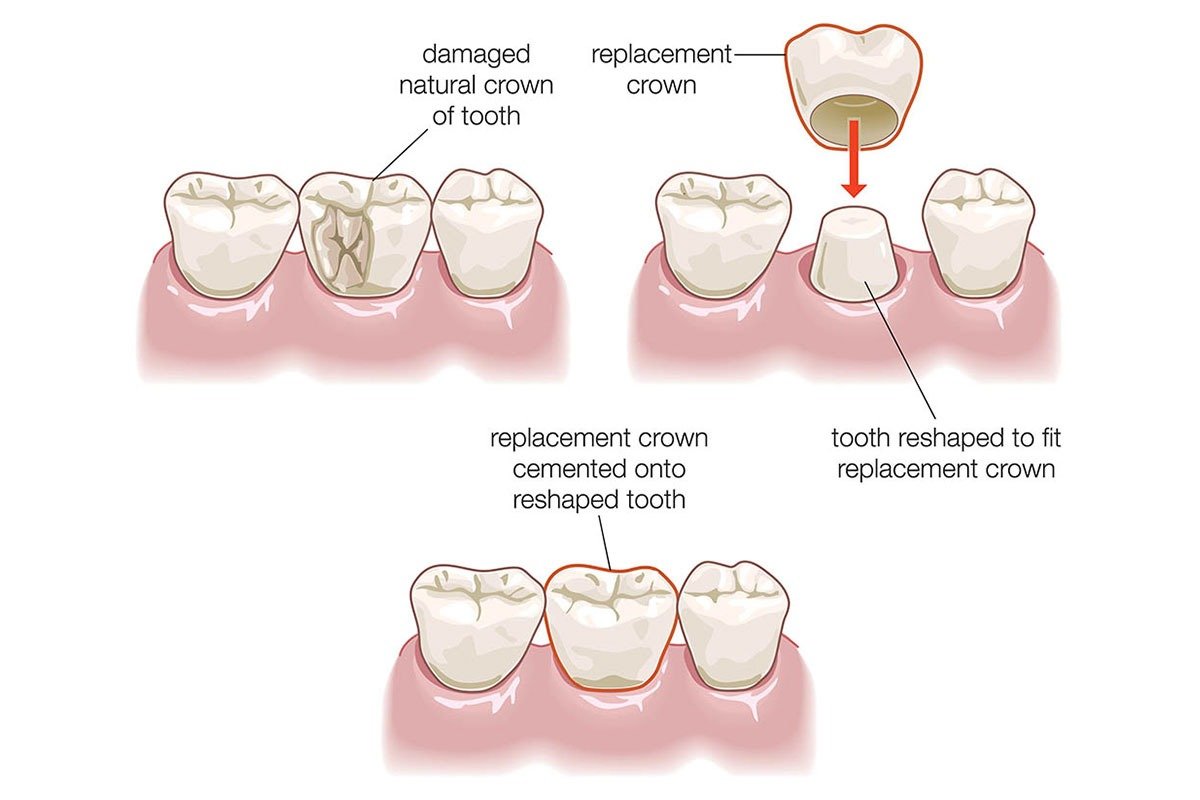Dental crowns also referred to as dental caps, are placed over the chipped, cracked, or damaged teeth and repair their form and function. Dental crowns are a dental restorative procedure that corrects dental issues and replaces worn-out fillings in order to restore the chewing abilities of damaged teeth. In addition to repairing cracked or fractured teeth, they also protect them from further damage and preserve their functionalities.
Dental crowns commonly fix issues like:
- Chipped, fractured, or broken teeth
- Badly discolored teeth
- Severely decayed teeth
- Infected teeth
- Short teeth
- Gapped teeth
Teeth can get weakened or damaged due to wear and tear, extensive dental fillings, fractures, or tooth decay and require immediate treatment in order to prevent severe oral problems. Dental crowns are tooth-colored caps that cover the visible portion of your teeth to improve their function and also uplift your appearance.
The placement of a dental crown usually requires two visits to your dentist. At the first visit, the dentists usually numb the mouth with the help of sedatives.
After that, they prepare the tooth for the crown by clearing away the decayed portion and shaving down the tooth so the crown will fit in the required place. In the second appointment, your dentist will place the permanent crowns over the decayed or damaged teeth.
1. DENTAL CROWNS HOLD THE CHIPPED TEETH TOGETHER
The dental crowns significantly protect the damaged or chipped teeth from further damage. They hold the fragmented parts of the tooth in place. This prevents the tooth from breaking furtherly into smaller pieces over time. In this way, dental crowns effectively fix teeth that have fragmented into multiple pieces and prevent the further spread of breakage.
2. DENTAL CROWNS KEEP TEETH SAFE FROM IRRITANTS PRESENT IN THE MOUTH:
Factors like food particles, bacteria, saliva, and acids become a reason for various dental issues. Dental crowns protect the teeth from all such factors and preserve their form and function. These restorative crowns fully encase the tooth and eliminate the reach of these substances to the affected tooth to cause more damage. Moreover, damaged or decayed teeth that are not protected by dental crowns are relatively at higher risk of damage.
3. DENTAL CROWNS PROTECT THE TEETH FROM BITE FORCES:
The dental crown also protects our teeth from the forces involved in chewing and biting. Preventing the teeth from bite forces becomes particularly important if the tooth has already been damaged. A crown significantly restores the function and structural integrity of the tooth, allowing the patient to speak and chew with the damaged tooth without causing any problems.
Moreover, dental crowns are fabricated from durable and sturdy materials like porcelain, metals, resin and ceramics, which can protect the teeth from damage for extended periods. They typically do not require special care or maintenance over time; one can preserve the quality of dental crowns simply by following a good oral hygiene routine regularly.
4. DENTAL CROWNS PROVIDE STRUCTURAL SUPPORT TO DAMAGED TEETH:
The chipped or fractured teeth get weakened by the loss of structure, during a surgical procedure or due to the damage. The damaged and weakened tooth does not function properly, and sometimes the dentists extract them.
Dental crowns are shaped and fit to slip over the weakened tooth while lending it all the support it needs to return to full and natural dental functionality. If you maintain good oral health by taking care of your gums, jaw, and teeth, the dental crowns will last a long time and will also protect your teeth from infections.
5. DENTAL CROWNS COVER THE DENTAL IMPLANTS:
In addition to providing protection to damaged, decayed or broken teeth, dental crowns also support and preserve the functionality of dental implants. The dental crowns are attached to the implants in two ways, either by using screws or by cementing the crowns on the abutment that connects to the dental implants.
The dental crowns significantly protect the form and function of dental implants for prolonged periods. Out of all types of crowns, solid zirconia crowns provide maximum support and protection to dental implants.
6. DENTAL CROWNS ALSO PROTECT TOOTH FILLINGS FROM DAMAGE:
The tooth fillings can crack, leak, or fall out over time due to wear and tear or decay. The worn-out fillings do not protect your teeth anymore and become a reason for bacterial accumulation. By placing dental crowns over the tooth fillings, we can protect their quality for extended periods as dental crowns encase and cover and prevent them from getting affected by contaminated substances.
The fillings usually repair the teeth with mild cavities or holes. However, they cannot repair the functionality of deeply damaged or decayed teeth; in such cases, dentists place dental crowns over your teeth to repair them and to stop the spread of infection or damage.











